Tesco Business Project: Challenges, Analysis, and Solutions
VerifiedAdded on 2023/02/07
|18
|6797
|40
Report
AI Summary
This report provides a comprehensive analysis of the challenges facing Tesco, a global retailer. It begins with an executive summary outlining the key issues, including declining product quality, ineffective marketing strategies, and corporate scandals. The report delves into these challenges, examining the impact on stakeholders such as customers, investors, and employees. Secondary data, including peer-reviewed publications, is evaluated to assess Tesco's product and service quality, marketing strategies, and overall business performance. A SWOT and PESTEL analysis are conducted to provide a deeper understanding of the company's strengths, weaknesses, opportunities, and threats. The report concludes with recommendations for Tesco, including improving product quality, adopting modern marketing techniques, and enhancing ethical auditing practices to regain consumer trust and improve financial performance. The report emphasizes the need for Tesco to adapt to changing consumer demands and address its internal and external challenges to maintain its market position.
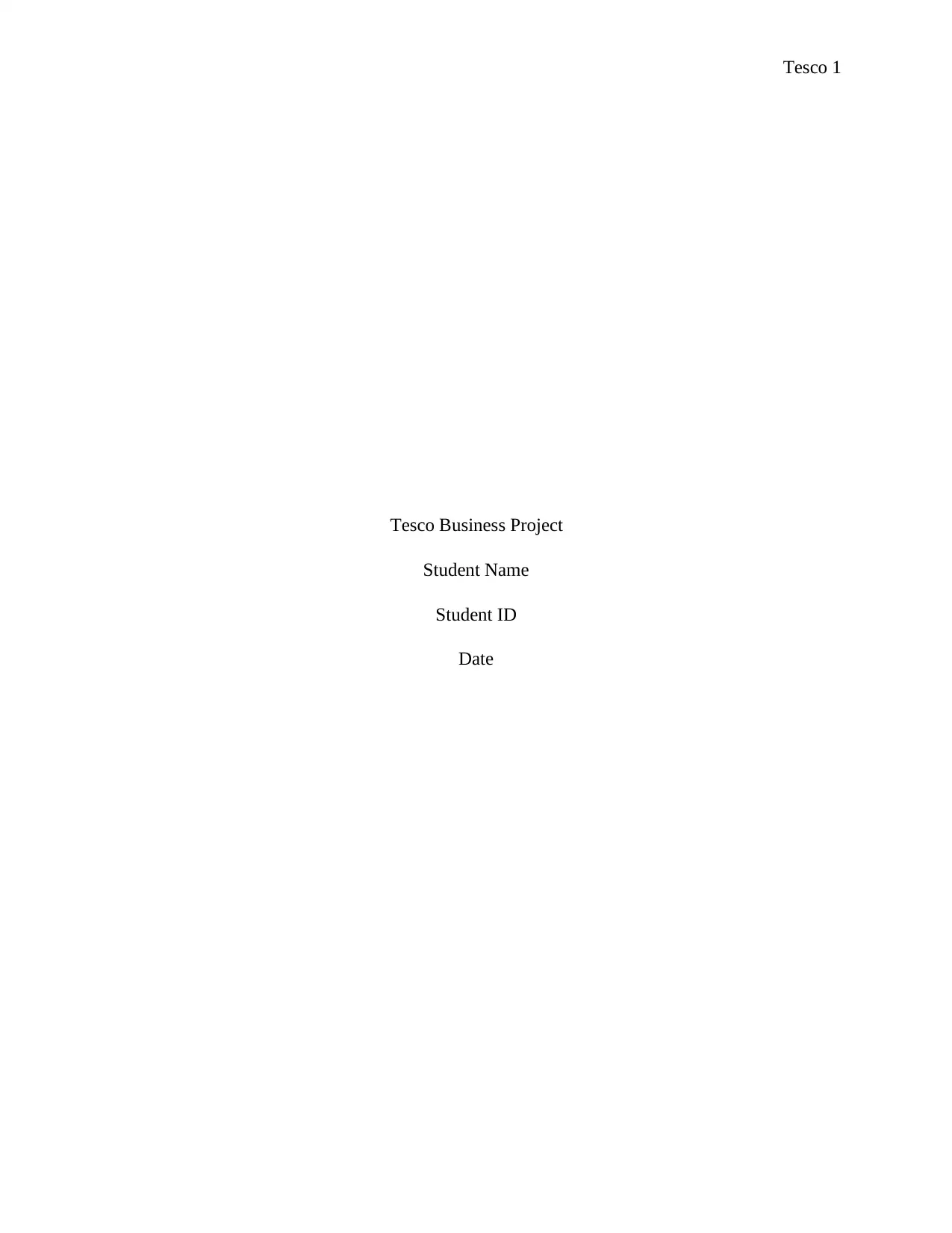
Tesco 1
Tesco Business Project
Student Name
Student ID
Date
Tesco Business Project
Student Name
Student ID
Date
Paraphrase This Document
Need a fresh take? Get an instant paraphrase of this document with our AI Paraphraser
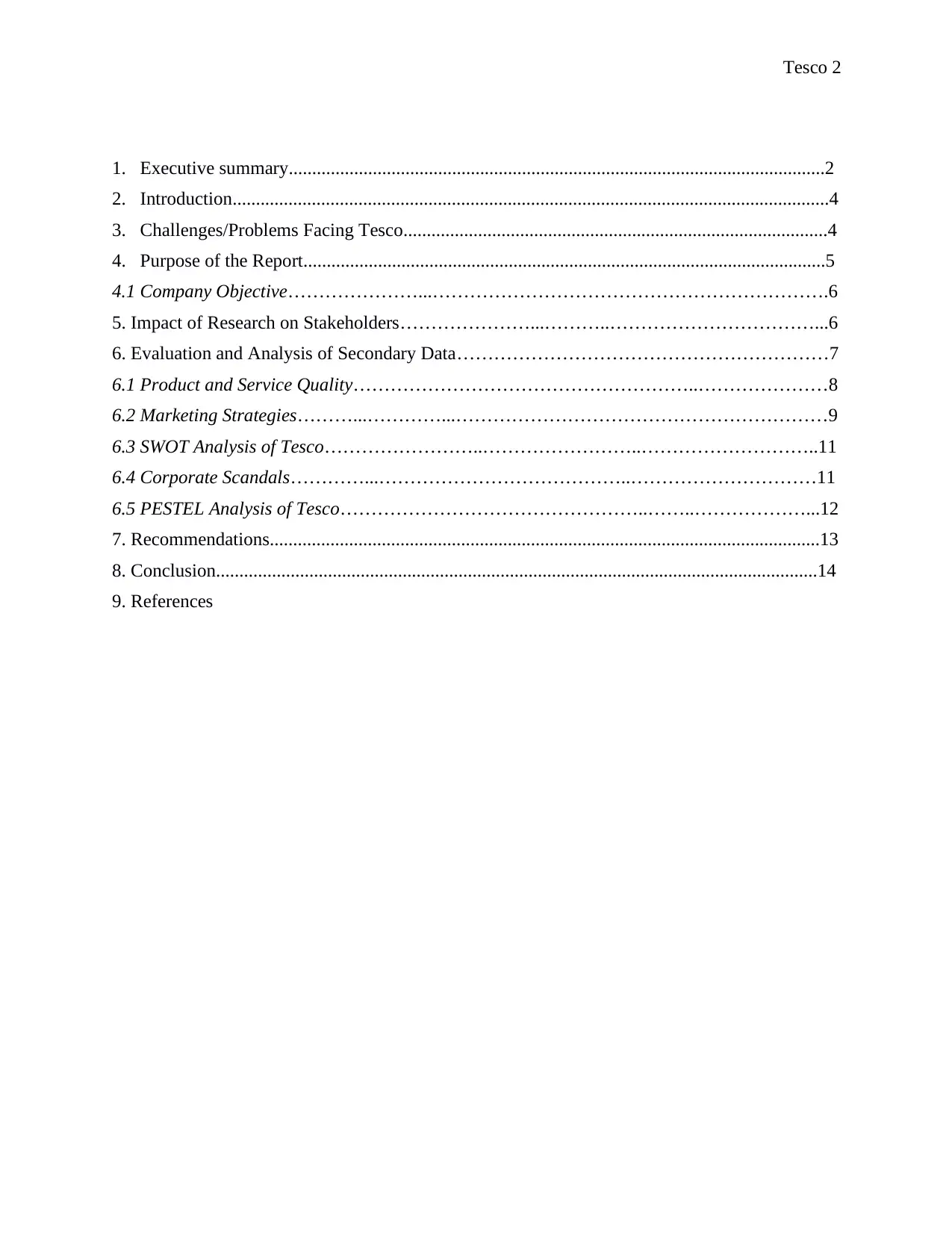
Tesco 2
1. Executive summary...................................................................................................................2
2. Introduction................................................................................................................................4
3. Challenges/Problems Facing Tesco...........................................................................................4
4. Purpose of the Report................................................................................................................5
4.1 Company Objective…………………...……………………………………………………….6
5. Impact of Research on Stakeholders…………………...………..……………………………...6
6. Evaluation and Analysis of Secondary Data……………………………………………………7
6.1 Product and Service Quality………………………………………………..…………………8
6.2 Marketing Strategies………...…………...……………………………………………………9
6.3 SWOT Analysis of Tesco……………………..……………………..………………………..11
6.4 Corporate Scandals…………...…………………………………..…………………………11
6.5 PESTEL Analysis of Tesco…………………………………………..……..………………...12
7. Recommendations......................................................................................................................13
8. Conclusion.................................................................................................................................14
9. References
1. Executive summary...................................................................................................................2
2. Introduction................................................................................................................................4
3. Challenges/Problems Facing Tesco...........................................................................................4
4. Purpose of the Report................................................................................................................5
4.1 Company Objective…………………...……………………………………………………….6
5. Impact of Research on Stakeholders…………………...………..……………………………...6
6. Evaluation and Analysis of Secondary Data……………………………………………………7
6.1 Product and Service Quality………………………………………………..…………………8
6.2 Marketing Strategies………...…………...……………………………………………………9
6.3 SWOT Analysis of Tesco……………………..……………………..………………………..11
6.4 Corporate Scandals…………...…………………………………..…………………………11
6.5 PESTEL Analysis of Tesco…………………………………………..……..………………...12
7. Recommendations......................................................................................................................13
8. Conclusion.................................................................................................................................14
9. References

Tesco 3
1. Executive summary
Identifying Tesco's present challenges and related to current events was the goal of this
investigation. Secondary data about Tesco's difficulties were evaluated and analyzed, and the
conclusions were presented. Peer-reviewed publications from Google Scholar were used to
compile the data. The results from secondary data were also used to provide suggestions for the
firm to solve the concerns. Several problems affect Tesco, including decreased product quality, a
lack of marketing strategy, and corporate scandals. Due to quality difficulties, Tesco is losing
consumers and market share to its rivals, even though it is one of the world's largest retailers.
Several Tesco shops have been shut down in the United States and Japan, and elsewhere in the
world.
The company's inadequate marketing methods are blamed for the shop closings. Consumers in
Tesco's overseas markets were unsatisfied with the company's marketing methods. As a result,
Tesco has opted to continue with tried-and-true promotion methods rather than embracing more
modern methods like social media marketing and media advertising. Several controversies have
also engulfed Tesco, such as discovering horsemeat in Tesco-branded burgers and erroneous
accounting. The study's findings revealed the varied perspectives of Tesco's many stakeholders
on the company's current state of affairs. Problems with product quality hurt client satisfaction
and purchasing decisions. Customers are less inclined to make repeat purchases when the items
are of lower quality. As a result, the company's profitability suffers, affecting investors' returns. It
is not only customers, investors, and workers that suffer from bad marketing. The firm will not
sell its items if it identifies the correct customers via poor marketing. That means the business
will be less competitive and will not make any money. The company's failure to produce
revenues means that its workers will be laid off. The research presented suggestions for Tesco
based on the results of secondary data, which is analyzed. According to a proposal from the
report, Tesco has to gather data on the existing quality and consumer demands, educate
personnel, and use technology to enhance its goods and services.
Additionally, the corporation should use contemporary marketing trends like social media
marketing and efficient market entrance techniques like joint ventures to better understand its
target consumers' cultural preferences. The second proposal is that Tesco's auditors should be
1. Executive summary
Identifying Tesco's present challenges and related to current events was the goal of this
investigation. Secondary data about Tesco's difficulties were evaluated and analyzed, and the
conclusions were presented. Peer-reviewed publications from Google Scholar were used to
compile the data. The results from secondary data were also used to provide suggestions for the
firm to solve the concerns. Several problems affect Tesco, including decreased product quality, a
lack of marketing strategy, and corporate scandals. Due to quality difficulties, Tesco is losing
consumers and market share to its rivals, even though it is one of the world's largest retailers.
Several Tesco shops have been shut down in the United States and Japan, and elsewhere in the
world.
The company's inadequate marketing methods are blamed for the shop closings. Consumers in
Tesco's overseas markets were unsatisfied with the company's marketing methods. As a result,
Tesco has opted to continue with tried-and-true promotion methods rather than embracing more
modern methods like social media marketing and media advertising. Several controversies have
also engulfed Tesco, such as discovering horsemeat in Tesco-branded burgers and erroneous
accounting. The study's findings revealed the varied perspectives of Tesco's many stakeholders
on the company's current state of affairs. Problems with product quality hurt client satisfaction
and purchasing decisions. Customers are less inclined to make repeat purchases when the items
are of lower quality. As a result, the company's profitability suffers, affecting investors' returns. It
is not only customers, investors, and workers that suffer from bad marketing. The firm will not
sell its items if it identifies the correct customers via poor marketing. That means the business
will be less competitive and will not make any money. The company's failure to produce
revenues means that its workers will be laid off. The research presented suggestions for Tesco
based on the results of secondary data, which is analyzed. According to a proposal from the
report, Tesco has to gather data on the existing quality and consumer demands, educate
personnel, and use technology to enhance its goods and services.
Additionally, the corporation should use contemporary marketing trends like social media
marketing and efficient market entrance techniques like joint ventures to better understand its
target consumers' cultural preferences. The second proposal is that Tesco's auditors should be
⊘ This is a preview!⊘
Do you want full access?
Subscribe today to unlock all pages.

Trusted by 1+ million students worldwide
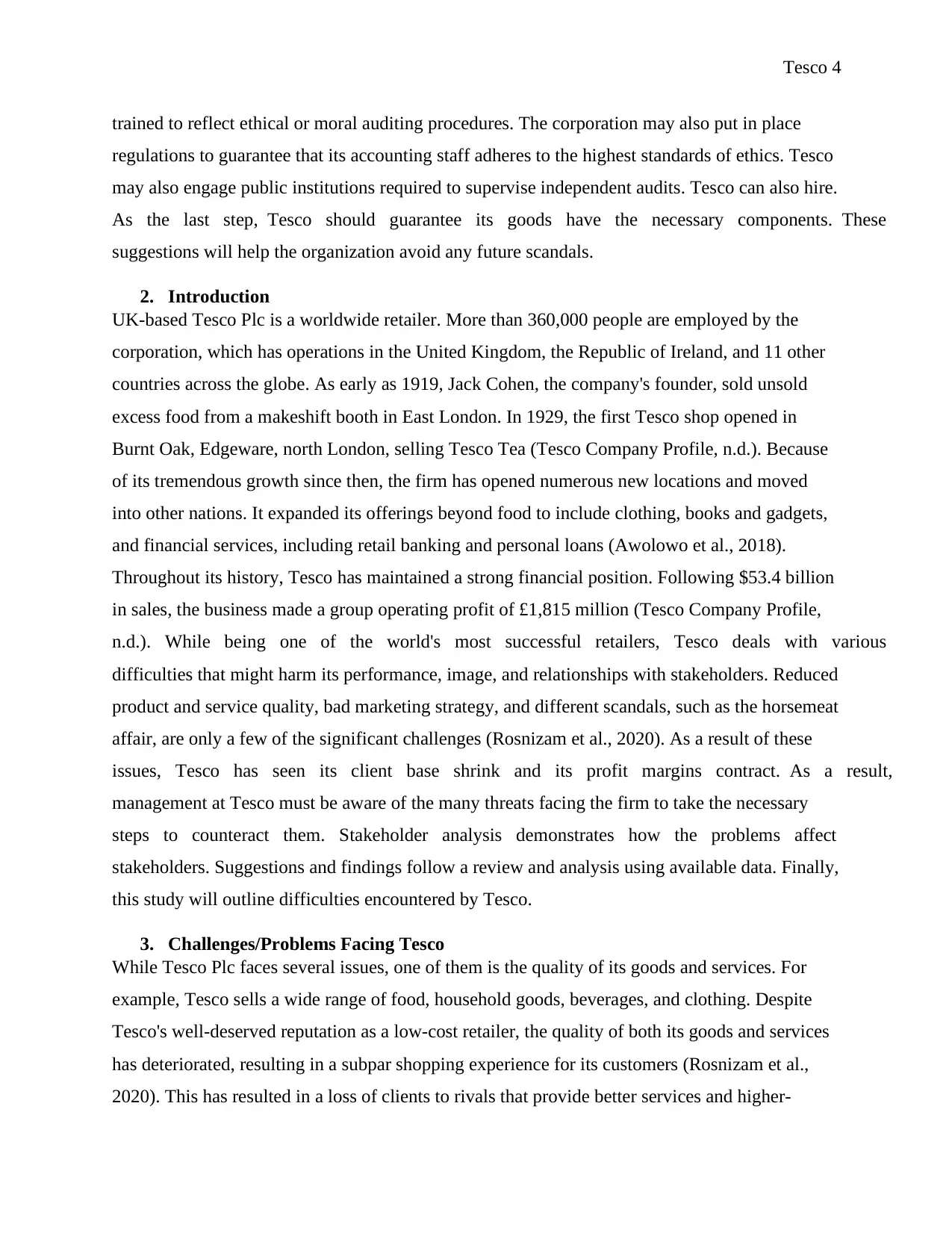
Tesco 4
trained to reflect ethical or moral auditing procedures. The corporation may also put in place
regulations to guarantee that its accounting staff adheres to the highest standards of ethics. Tesco
may also engage public institutions required to supervise independent audits. Tesco can also hire.
As the last step, Tesco should guarantee its goods have the necessary components. These
suggestions will help the organization avoid any future scandals.
2. Introduction
UK-based Tesco Plc is a worldwide retailer. More than 360,000 people are employed by the
corporation, which has operations in the United Kingdom, the Republic of Ireland, and 11 other
countries across the globe. As early as 1919, Jack Cohen, the company's founder, sold unsold
excess food from a makeshift booth in East London. In 1929, the first Tesco shop opened in
Burnt Oak, Edgeware, north London, selling Tesco Tea (Tesco Company Profile, n.d.). Because
of its tremendous growth since then, the firm has opened numerous new locations and moved
into other nations. It expanded its offerings beyond food to include clothing, books and gadgets,
and financial services, including retail banking and personal loans (Awolowo et al., 2018).
Throughout its history, Tesco has maintained a strong financial position. Following $53.4 billion
in sales, the business made a group operating profit of £1,815 million (Tesco Company Profile,
n.d.). While being one of the world's most successful retailers, Tesco deals with various
difficulties that might harm its performance, image, and relationships with stakeholders. Reduced
product and service quality, bad marketing strategy, and different scandals, such as the horsemeat
affair, are only a few of the significant challenges (Rosnizam et al., 2020). As a result of these
issues, Tesco has seen its client base shrink and its profit margins contract. As a result,
management at Tesco must be aware of the many threats facing the firm to take the necessary
steps to counteract them. Stakeholder analysis demonstrates how the problems affect
stakeholders. Suggestions and findings follow a review and analysis using available data. Finally,
this study will outline difficulties encountered by Tesco.
3. Challenges/Problems Facing Tesco
While Tesco Plc faces several issues, one of them is the quality of its goods and services. For
example, Tesco sells a wide range of food, household goods, beverages, and clothing. Despite
Tesco's well-deserved reputation as a low-cost retailer, the quality of both its goods and services
has deteriorated, resulting in a subpar shopping experience for its customers (Rosnizam et al.,
2020). This has resulted in a loss of clients to rivals that provide better services and higher-
trained to reflect ethical or moral auditing procedures. The corporation may also put in place
regulations to guarantee that its accounting staff adheres to the highest standards of ethics. Tesco
may also engage public institutions required to supervise independent audits. Tesco can also hire.
As the last step, Tesco should guarantee its goods have the necessary components. These
suggestions will help the organization avoid any future scandals.
2. Introduction
UK-based Tesco Plc is a worldwide retailer. More than 360,000 people are employed by the
corporation, which has operations in the United Kingdom, the Republic of Ireland, and 11 other
countries across the globe. As early as 1919, Jack Cohen, the company's founder, sold unsold
excess food from a makeshift booth in East London. In 1929, the first Tesco shop opened in
Burnt Oak, Edgeware, north London, selling Tesco Tea (Tesco Company Profile, n.d.). Because
of its tremendous growth since then, the firm has opened numerous new locations and moved
into other nations. It expanded its offerings beyond food to include clothing, books and gadgets,
and financial services, including retail banking and personal loans (Awolowo et al., 2018).
Throughout its history, Tesco has maintained a strong financial position. Following $53.4 billion
in sales, the business made a group operating profit of £1,815 million (Tesco Company Profile,
n.d.). While being one of the world's most successful retailers, Tesco deals with various
difficulties that might harm its performance, image, and relationships with stakeholders. Reduced
product and service quality, bad marketing strategy, and different scandals, such as the horsemeat
affair, are only a few of the significant challenges (Rosnizam et al., 2020). As a result of these
issues, Tesco has seen its client base shrink and its profit margins contract. As a result,
management at Tesco must be aware of the many threats facing the firm to take the necessary
steps to counteract them. Stakeholder analysis demonstrates how the problems affect
stakeholders. Suggestions and findings follow a review and analysis using available data. Finally,
this study will outline difficulties encountered by Tesco.
3. Challenges/Problems Facing Tesco
While Tesco Plc faces several issues, one of them is the quality of its goods and services. For
example, Tesco sells a wide range of food, household goods, beverages, and clothing. Despite
Tesco's well-deserved reputation as a low-cost retailer, the quality of both its goods and services
has deteriorated, resulting in a subpar shopping experience for its customers (Rosnizam et al.,
2020). This has resulted in a loss of clients to rivals that provide better services and higher-
Paraphrase This Document
Need a fresh take? Get an instant paraphrase of this document with our AI Paraphraser
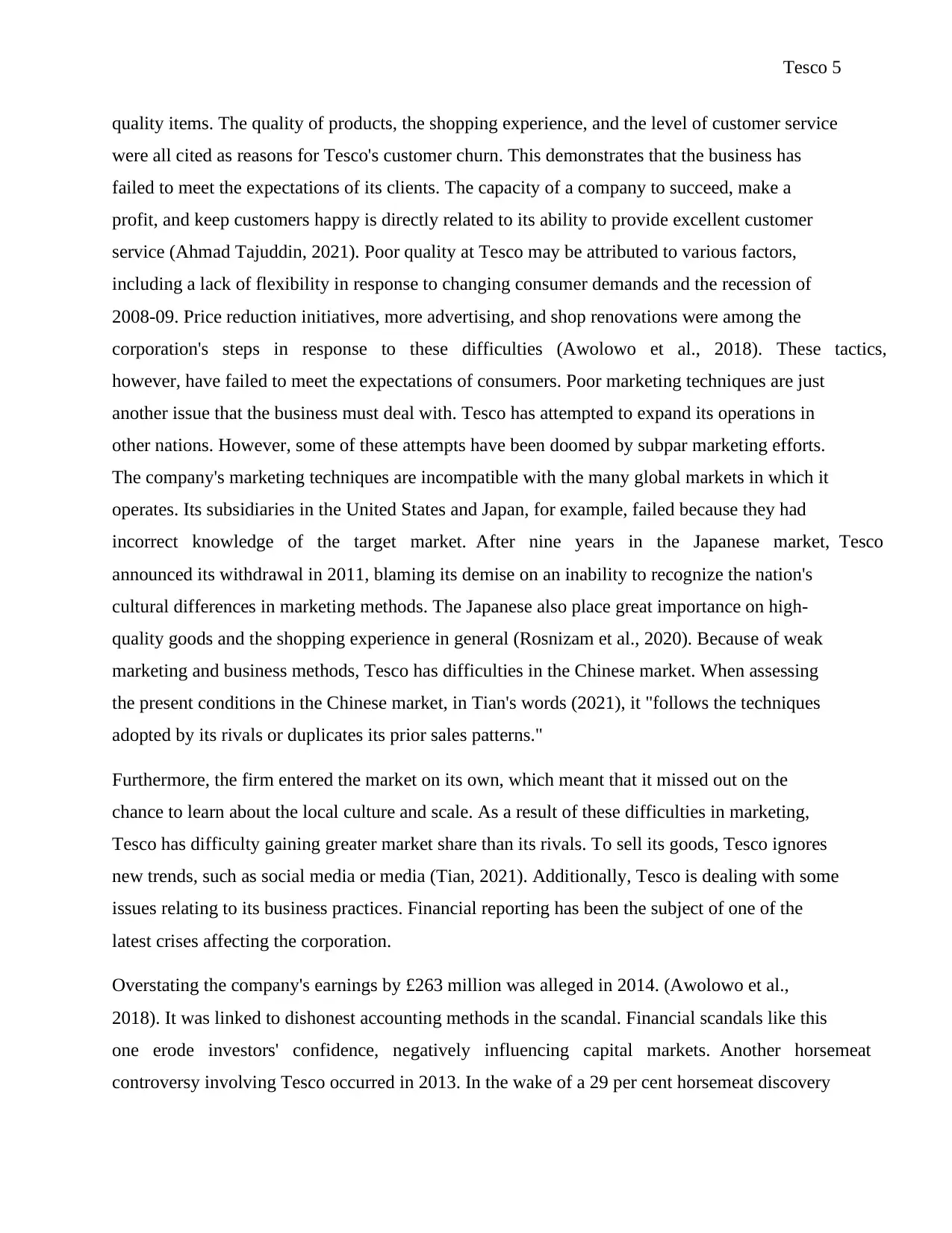
Tesco 5
quality items. The quality of products, the shopping experience, and the level of customer service
were all cited as reasons for Tesco's customer churn. This demonstrates that the business has
failed to meet the expectations of its clients. The capacity of a company to succeed, make a
profit, and keep customers happy is directly related to its ability to provide excellent customer
service (Ahmad Tajuddin, 2021). Poor quality at Tesco may be attributed to various factors,
including a lack of flexibility in response to changing consumer demands and the recession of
2008-09. Price reduction initiatives, more advertising, and shop renovations were among the
corporation's steps in response to these difficulties (Awolowo et al., 2018). These tactics,
however, have failed to meet the expectations of consumers. Poor marketing techniques are just
another issue that the business must deal with. Tesco has attempted to expand its operations in
other nations. However, some of these attempts have been doomed by subpar marketing efforts.
The company's marketing techniques are incompatible with the many global markets in which it
operates. Its subsidiaries in the United States and Japan, for example, failed because they had
incorrect knowledge of the target market. After nine years in the Japanese market, Tesco
announced its withdrawal in 2011, blaming its demise on an inability to recognize the nation's
cultural differences in marketing methods. The Japanese also place great importance on high-
quality goods and the shopping experience in general (Rosnizam et al., 2020). Because of weak
marketing and business methods, Tesco has difficulties in the Chinese market. When assessing
the present conditions in the Chinese market, in Tian's words (2021), it "follows the techniques
adopted by its rivals or duplicates its prior sales patterns."
Furthermore, the firm entered the market on its own, which meant that it missed out on the
chance to learn about the local culture and scale. As a result of these difficulties in marketing,
Tesco has difficulty gaining greater market share than its rivals. To sell its goods, Tesco ignores
new trends, such as social media or media (Tian, 2021). Additionally, Tesco is dealing with some
issues relating to its business practices. Financial reporting has been the subject of one of the
latest crises affecting the corporation.
Overstating the company's earnings by £263 million was alleged in 2014. (Awolowo et al.,
2018). It was linked to dishonest accounting methods in the scandal. Financial scandals like this
one erode investors' confidence, negatively influencing capital markets. Another horsemeat
controversy involving Tesco occurred in 2013. In the wake of a 29 per cent horsemeat discovery
quality items. The quality of products, the shopping experience, and the level of customer service
were all cited as reasons for Tesco's customer churn. This demonstrates that the business has
failed to meet the expectations of its clients. The capacity of a company to succeed, make a
profit, and keep customers happy is directly related to its ability to provide excellent customer
service (Ahmad Tajuddin, 2021). Poor quality at Tesco may be attributed to various factors,
including a lack of flexibility in response to changing consumer demands and the recession of
2008-09. Price reduction initiatives, more advertising, and shop renovations were among the
corporation's steps in response to these difficulties (Awolowo et al., 2018). These tactics,
however, have failed to meet the expectations of consumers. Poor marketing techniques are just
another issue that the business must deal with. Tesco has attempted to expand its operations in
other nations. However, some of these attempts have been doomed by subpar marketing efforts.
The company's marketing techniques are incompatible with the many global markets in which it
operates. Its subsidiaries in the United States and Japan, for example, failed because they had
incorrect knowledge of the target market. After nine years in the Japanese market, Tesco
announced its withdrawal in 2011, blaming its demise on an inability to recognize the nation's
cultural differences in marketing methods. The Japanese also place great importance on high-
quality goods and the shopping experience in general (Rosnizam et al., 2020). Because of weak
marketing and business methods, Tesco has difficulties in the Chinese market. When assessing
the present conditions in the Chinese market, in Tian's words (2021), it "follows the techniques
adopted by its rivals or duplicates its prior sales patterns."
Furthermore, the firm entered the market on its own, which meant that it missed out on the
chance to learn about the local culture and scale. As a result of these difficulties in marketing,
Tesco has difficulty gaining greater market share than its rivals. To sell its goods, Tesco ignores
new trends, such as social media or media (Tian, 2021). Additionally, Tesco is dealing with some
issues relating to its business practices. Financial reporting has been the subject of one of the
latest crises affecting the corporation.
Overstating the company's earnings by £263 million was alleged in 2014. (Awolowo et al.,
2018). It was linked to dishonest accounting methods in the scandal. Financial scandals like this
one erode investors' confidence, negatively influencing capital markets. Another horsemeat
controversy involving Tesco occurred in 2013. In the wake of a 29 per cent horsemeat discovery
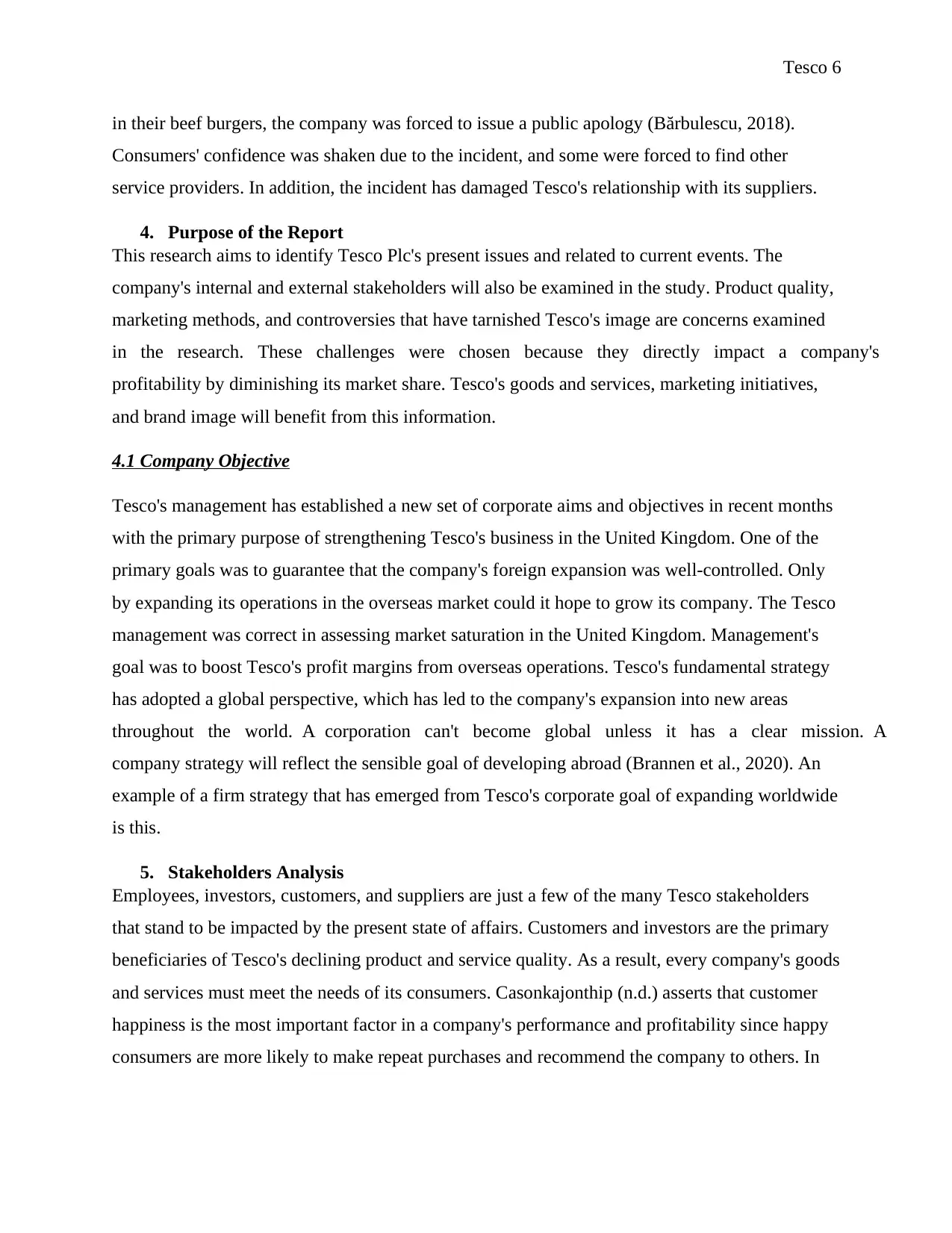
Tesco 6
in their beef burgers, the company was forced to issue a public apology (Bărbulescu, 2018).
Consumers' confidence was shaken due to the incident, and some were forced to find other
service providers. In addition, the incident has damaged Tesco's relationship with its suppliers.
4. Purpose of the Report
This research aims to identify Tesco Plc's present issues and related to current events. The
company's internal and external stakeholders will also be examined in the study. Product quality,
marketing methods, and controversies that have tarnished Tesco's image are concerns examined
in the research. These challenges were chosen because they directly impact a company's
profitability by diminishing its market share. Tesco's goods and services, marketing initiatives,
and brand image will benefit from this information.
4.1 Company Objective
Tesco's management has established a new set of corporate aims and objectives in recent months
with the primary purpose of strengthening Tesco's business in the United Kingdom. One of the
primary goals was to guarantee that the company's foreign expansion was well-controlled. Only
by expanding its operations in the overseas market could it hope to grow its company. The Tesco
management was correct in assessing market saturation in the United Kingdom. Management's
goal was to boost Tesco's profit margins from overseas operations. Tesco's fundamental strategy
has adopted a global perspective, which has led to the company's expansion into new areas
throughout the world. A corporation can't become global unless it has a clear mission. A
company strategy will reflect the sensible goal of developing abroad (Brannen et al., 2020). An
example of a firm strategy that has emerged from Tesco's corporate goal of expanding worldwide
is this.
5. Stakeholders Analysis
Employees, investors, customers, and suppliers are just a few of the many Tesco stakeholders
that stand to be impacted by the present state of affairs. Customers and investors are the primary
beneficiaries of Tesco's declining product and service quality. As a result, every company's goods
and services must meet the needs of its consumers. Casonkajonthip (n.d.) asserts that customer
happiness is the most important factor in a company's performance and profitability since happy
consumers are more likely to make repeat purchases and recommend the company to others. In
in their beef burgers, the company was forced to issue a public apology (Bărbulescu, 2018).
Consumers' confidence was shaken due to the incident, and some were forced to find other
service providers. In addition, the incident has damaged Tesco's relationship with its suppliers.
4. Purpose of the Report
This research aims to identify Tesco Plc's present issues and related to current events. The
company's internal and external stakeholders will also be examined in the study. Product quality,
marketing methods, and controversies that have tarnished Tesco's image are concerns examined
in the research. These challenges were chosen because they directly impact a company's
profitability by diminishing its market share. Tesco's goods and services, marketing initiatives,
and brand image will benefit from this information.
4.1 Company Objective
Tesco's management has established a new set of corporate aims and objectives in recent months
with the primary purpose of strengthening Tesco's business in the United Kingdom. One of the
primary goals was to guarantee that the company's foreign expansion was well-controlled. Only
by expanding its operations in the overseas market could it hope to grow its company. The Tesco
management was correct in assessing market saturation in the United Kingdom. Management's
goal was to boost Tesco's profit margins from overseas operations. Tesco's fundamental strategy
has adopted a global perspective, which has led to the company's expansion into new areas
throughout the world. A corporation can't become global unless it has a clear mission. A
company strategy will reflect the sensible goal of developing abroad (Brannen et al., 2020). An
example of a firm strategy that has emerged from Tesco's corporate goal of expanding worldwide
is this.
5. Stakeholders Analysis
Employees, investors, customers, and suppliers are just a few of the many Tesco stakeholders
that stand to be impacted by the present state of affairs. Customers and investors are the primary
beneficiaries of Tesco's declining product and service quality. As a result, every company's goods
and services must meet the needs of its consumers. Casonkajonthip (n.d.) asserts that customer
happiness is the most important factor in a company's performance and profitability since happy
consumers are more likely to make repeat purchases and recommend the company to others. In
⊘ This is a preview!⊘
Do you want full access?
Subscribe today to unlock all pages.

Trusted by 1+ million students worldwide

Tesco 7
other words, clients are more likely to stick with a business if they are happy with the items and
services they get.
On the other hand, dissatisfied consumers are more inclined to criticize the firm and go to a
competitor. Quality difficulties with Tesco's goods, customer service, and customer experience
resulted in a loss of consumers (Daudigeos et al., 2020). Poor quality is expensive since it results
in waste. In Fatricia (2017), the authors said that a company's capacity to provide high-quality
products and services increases customer loyalty and profitability. A company's reputation and
profitability influence the number of investors who are prepared to put their money and resources
into the business in the hopes of seeing a return on their investment.
On the other hand, an inferior firm has a bad image, makes little money, and scares prospective
investors. If a corporation cannot profit, it will be forced to lay off workers since they will not be
paid. Tesco's overseas shops were shut down in the US and Japan due to massive losses. The
termination of business ties with vendors is another consequence of shop closings. Customers are
impacted in a variety of ways by marketing concerns. This impacts consumers in the form of
segmentation, for example. Customer demands may be segmented depending on various factors,
such as the cost, specificity, and kind of product, such as custom-made items. Tesco used
demographic and regional characteristics to categorize its target market. Customers with
demographic factors including age 16-25, 25-45, with or without family, and over 60 are targeted
by Tesco's club card magazine (Gourlay, 2018). Teasing consumers with its catchphrase "fresh &
simple" in the United States, Tesco sought to appeal to health-conscious shoppers who place
more emphasis on price and convenience than on a healthy image (Jennifer Weitzel, 2017). The
firm could not find suitable consumers using these methods, which resulted in a waste of
resources and financial losses. This is causing Tesco to fall farther behind in the European market
share stakes due to its inability to target a specific client base properly. Due to Tesco's
concentration on overseas operations, underinvestment in the UK market has resulted in a
shortage of employees, problems with its marketing, and a loss of market share (Khafizov and
Nurullin, 2017).
Consumer behaviour is important in marketing because it reveals what the target audience wants.
In particular, in the Chinese market, Tesco, on the other hand, failed to take customer behaviour
into account when devising its marketing techniques. According to Tian (2021), Tesco's China
other words, clients are more likely to stick with a business if they are happy with the items and
services they get.
On the other hand, dissatisfied consumers are more inclined to criticize the firm and go to a
competitor. Quality difficulties with Tesco's goods, customer service, and customer experience
resulted in a loss of consumers (Daudigeos et al., 2020). Poor quality is expensive since it results
in waste. In Fatricia (2017), the authors said that a company's capacity to provide high-quality
products and services increases customer loyalty and profitability. A company's reputation and
profitability influence the number of investors who are prepared to put their money and resources
into the business in the hopes of seeing a return on their investment.
On the other hand, an inferior firm has a bad image, makes little money, and scares prospective
investors. If a corporation cannot profit, it will be forced to lay off workers since they will not be
paid. Tesco's overseas shops were shut down in the US and Japan due to massive losses. The
termination of business ties with vendors is another consequence of shop closings. Customers are
impacted in a variety of ways by marketing concerns. This impacts consumers in the form of
segmentation, for example. Customer demands may be segmented depending on various factors,
such as the cost, specificity, and kind of product, such as custom-made items. Tesco used
demographic and regional characteristics to categorize its target market. Customers with
demographic factors including age 16-25, 25-45, with or without family, and over 60 are targeted
by Tesco's club card magazine (Gourlay, 2018). Teasing consumers with its catchphrase "fresh &
simple" in the United States, Tesco sought to appeal to health-conscious shoppers who place
more emphasis on price and convenience than on a healthy image (Jennifer Weitzel, 2017). The
firm could not find suitable consumers using these methods, which resulted in a waste of
resources and financial losses. This is causing Tesco to fall farther behind in the European market
share stakes due to its inability to target a specific client base properly. Due to Tesco's
concentration on overseas operations, underinvestment in the UK market has resulted in a
shortage of employees, problems with its marketing, and a loss of market share (Khafizov and
Nurullin, 2017).
Consumer behaviour is important in marketing because it reveals what the target audience wants.
In particular, in the Chinese market, Tesco, on the other hand, failed to take customer behaviour
into account when devising its marketing techniques. According to Tian (2021), Tesco's China
Paraphrase This Document
Need a fresh take? Get an instant paraphrase of this document with our AI Paraphraser

Tesco 8
approach failed because Chinese consumers love free or discounted goods, but Tesco failed to
recognize the importance of cultural context. Stakeholders have been affected in various ways by
Tesco's scandals. Investors and clients flee to rivals when scandals tarnish a company's
reputation. These problems also affect the relationship between the business and its vendors. For
example, Tesco's relationship with multiple suppliers was strained during the horsemeat
controversy. Employees' jobs might be terminated as a result of scandals. As a case in point, the
accounting controversy that led to the overstatement of earnings resulted in the dismissal of
individuals responsible (Kizil and Kaşbaşı, 2018).
6. Evaluation and Analysis of Secondary Data
Tesco's present problems with product and service quality, marketing methods, and controversies
have been extensively researched in the literature. Examining secondary data will discover the
connection between these concerns and current events. Google Scholar peer-reviewed papers
were used to gather secondary data for this study. There were only papers published in the recent
ten years evaluated. The study's conclusions are broken down into many areas: product and
service quality, marketing techniques, and more. Contrasting viewpoints were used to analyze
the data.
6.1 Product and Service Quality
Product or service quality has been described as fulfilling consumers' demands (Lin and Peng,
2018). Products and services have been thoroughly tested for quality. According to results from
secondary data analysis, enterprises can increase their market share by focusing on product
quality and recommending certain methods. According to Ondrák (2019), examining an
organization's functioning, performance, and product quality might be a starting point for a more
comprehensive approach. This is followed by product indications and the consumer's perception
of relevance to the product.
Last but not least, the plan for product quality must be devised and implemented using the
information gathered. Following these procedures, a company may expand its market share after
the quality of its goods and services has been achieved. Because Tesco is losing market share to
its rivals, one of its quality problems, these results will help the corporation increase its market
share domestically and internationally.
approach failed because Chinese consumers love free or discounted goods, but Tesco failed to
recognize the importance of cultural context. Stakeholders have been affected in various ways by
Tesco's scandals. Investors and clients flee to rivals when scandals tarnish a company's
reputation. These problems also affect the relationship between the business and its vendors. For
example, Tesco's relationship with multiple suppliers was strained during the horsemeat
controversy. Employees' jobs might be terminated as a result of scandals. As a case in point, the
accounting controversy that led to the overstatement of earnings resulted in the dismissal of
individuals responsible (Kizil and Kaşbaşı, 2018).
6. Evaluation and Analysis of Secondary Data
Tesco's present problems with product and service quality, marketing methods, and controversies
have been extensively researched in the literature. Examining secondary data will discover the
connection between these concerns and current events. Google Scholar peer-reviewed papers
were used to gather secondary data for this study. There were only papers published in the recent
ten years evaluated. The study's conclusions are broken down into many areas: product and
service quality, marketing techniques, and more. Contrasting viewpoints were used to analyze
the data.
6.1 Product and Service Quality
Product or service quality has been described as fulfilling consumers' demands (Lin and Peng,
2018). Products and services have been thoroughly tested for quality. According to results from
secondary data analysis, enterprises can increase their market share by focusing on product
quality and recommending certain methods. According to Ondrák (2019), examining an
organization's functioning, performance, and product quality might be a starting point for a more
comprehensive approach. This is followed by product indications and the consumer's perception
of relevance to the product.
Last but not least, the plan for product quality must be devised and implemented using the
information gathered. Following these procedures, a company may expand its market share after
the quality of its goods and services has been achieved. Because Tesco is losing market share to
its rivals, one of its quality problems, these results will help the corporation increase its market
share domestically and internationally.
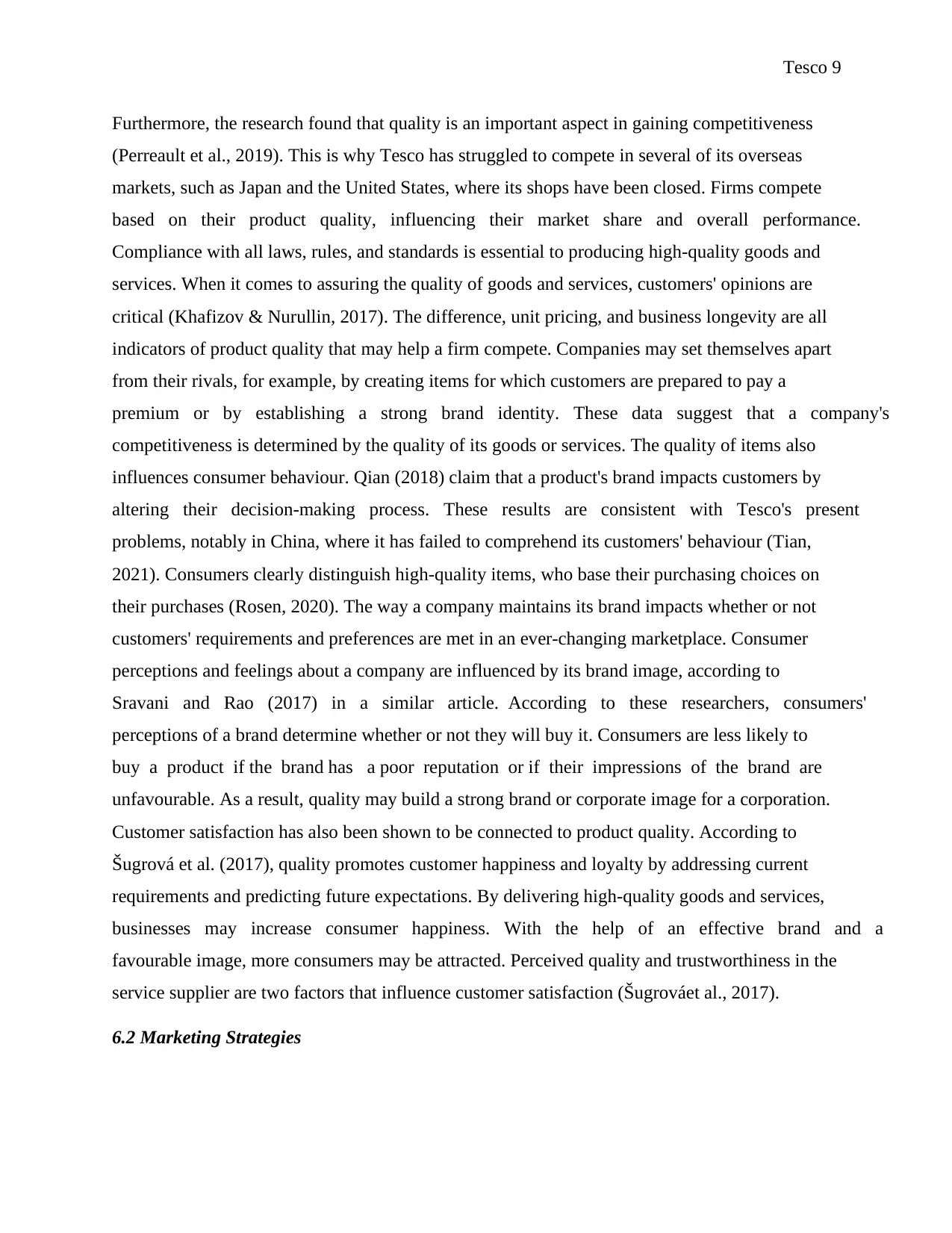
Tesco 9
Furthermore, the research found that quality is an important aspect in gaining competitiveness
(Perreault et al., 2019). This is why Tesco has struggled to compete in several of its overseas
markets, such as Japan and the United States, where its shops have been closed. Firms compete
based on their product quality, influencing their market share and overall performance.
Compliance with all laws, rules, and standards is essential to producing high-quality goods and
services. When it comes to assuring the quality of goods and services, customers' opinions are
critical (Khafizov & Nurullin, 2017). The difference, unit pricing, and business longevity are all
indicators of product quality that may help a firm compete. Companies may set themselves apart
from their rivals, for example, by creating items for which customers are prepared to pay a
premium or by establishing a strong brand identity. These data suggest that a company's
competitiveness is determined by the quality of its goods or services. The quality of items also
influences consumer behaviour. Qian (2018) claim that a product's brand impacts customers by
altering their decision-making process. These results are consistent with Tesco's present
problems, notably in China, where it has failed to comprehend its customers' behaviour (Tian,
2021). Consumers clearly distinguish high-quality items, who base their purchasing choices on
their purchases (Rosen, 2020). The way a company maintains its brand impacts whether or not
customers' requirements and preferences are met in an ever-changing marketplace. Consumer
perceptions and feelings about a company are influenced by its brand image, according to
Sravani and Rao (2017) in a similar article. According to these researchers, consumers'
perceptions of a brand determine whether or not they will buy it. Consumers are less likely to
buy a product if the brand has a poor reputation or if their impressions of the brand are
unfavourable. As a result, quality may build a strong brand or corporate image for a corporation.
Customer satisfaction has also been shown to be connected to product quality. According to
Šugrová et al. (2017), quality promotes customer happiness and loyalty by addressing current
requirements and predicting future expectations. By delivering high-quality goods and services,
businesses may increase consumer happiness. With the help of an effective brand and a
favourable image, more consumers may be attracted. Perceived quality and trustworthiness in the
service supplier are two factors that influence customer satisfaction (Šugrováet al., 2017).
6.2 Marketing Strategies
Furthermore, the research found that quality is an important aspect in gaining competitiveness
(Perreault et al., 2019). This is why Tesco has struggled to compete in several of its overseas
markets, such as Japan and the United States, where its shops have been closed. Firms compete
based on their product quality, influencing their market share and overall performance.
Compliance with all laws, rules, and standards is essential to producing high-quality goods and
services. When it comes to assuring the quality of goods and services, customers' opinions are
critical (Khafizov & Nurullin, 2017). The difference, unit pricing, and business longevity are all
indicators of product quality that may help a firm compete. Companies may set themselves apart
from their rivals, for example, by creating items for which customers are prepared to pay a
premium or by establishing a strong brand identity. These data suggest that a company's
competitiveness is determined by the quality of its goods or services. The quality of items also
influences consumer behaviour. Qian (2018) claim that a product's brand impacts customers by
altering their decision-making process. These results are consistent with Tesco's present
problems, notably in China, where it has failed to comprehend its customers' behaviour (Tian,
2021). Consumers clearly distinguish high-quality items, who base their purchasing choices on
their purchases (Rosen, 2020). The way a company maintains its brand impacts whether or not
customers' requirements and preferences are met in an ever-changing marketplace. Consumer
perceptions and feelings about a company are influenced by its brand image, according to
Sravani and Rao (2017) in a similar article. According to these researchers, consumers'
perceptions of a brand determine whether or not they will buy it. Consumers are less likely to
buy a product if the brand has a poor reputation or if their impressions of the brand are
unfavourable. As a result, quality may build a strong brand or corporate image for a corporation.
Customer satisfaction has also been shown to be connected to product quality. According to
Šugrová et al. (2017), quality promotes customer happiness and loyalty by addressing current
requirements and predicting future expectations. By delivering high-quality goods and services,
businesses may increase consumer happiness. With the help of an effective brand and a
favourable image, more consumers may be attracted. Perceived quality and trustworthiness in the
service supplier are two factors that influence customer satisfaction (Šugrováet al., 2017).
6.2 Marketing Strategies
⊘ This is a preview!⊘
Do you want full access?
Subscribe today to unlock all pages.

Trusted by 1+ million students worldwide
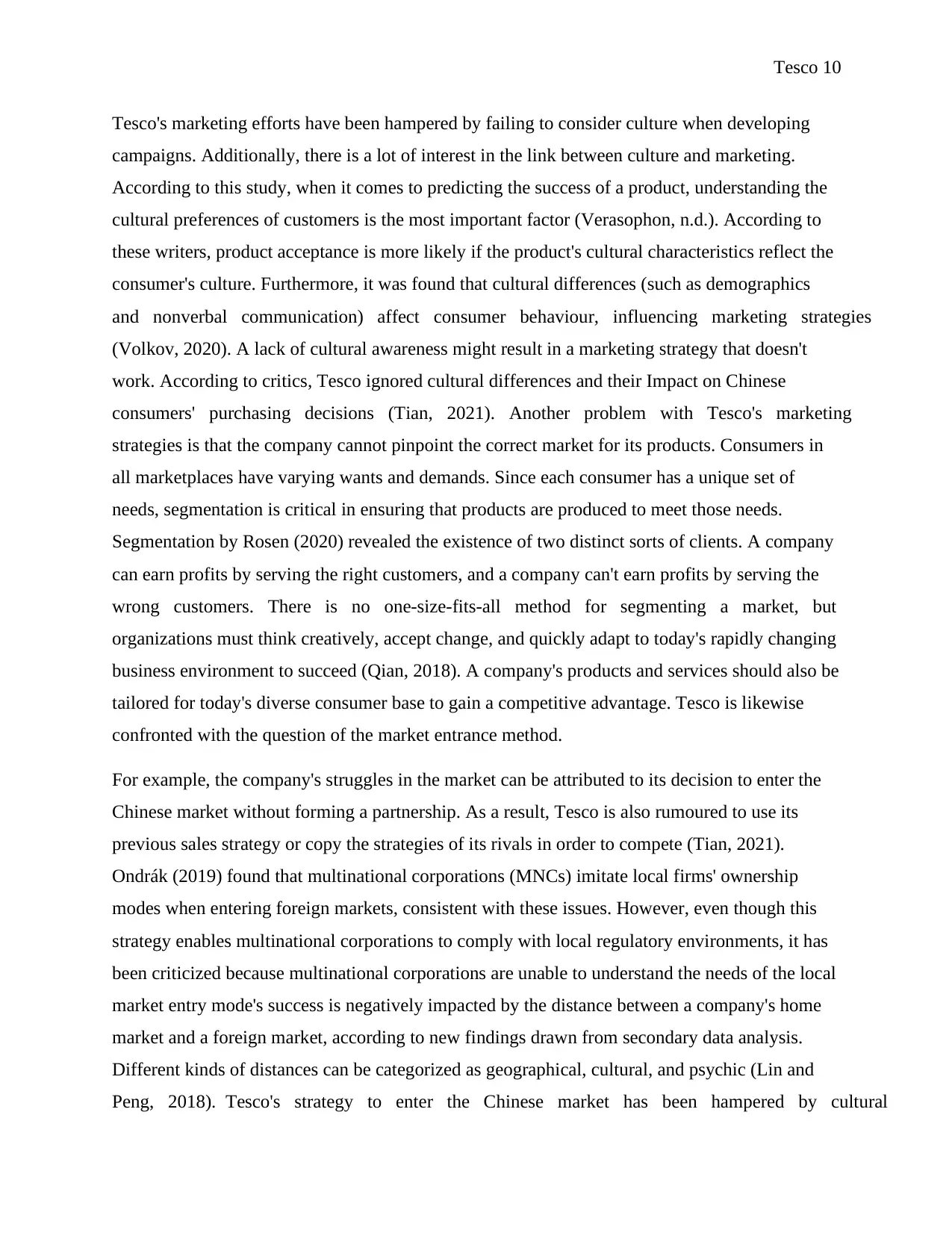
Tesco 10
Tesco's marketing efforts have been hampered by failing to consider culture when developing
campaigns. Additionally, there is a lot of interest in the link between culture and marketing.
According to this study, when it comes to predicting the success of a product, understanding the
cultural preferences of customers is the most important factor (Verasophon, n.d.). According to
these writers, product acceptance is more likely if the product's cultural characteristics reflect the
consumer's culture. Furthermore, it was found that cultural differences (such as demographics
and nonverbal communication) affect consumer behaviour, influencing marketing strategies
(Volkov, 2020). A lack of cultural awareness might result in a marketing strategy that doesn't
work. According to critics, Tesco ignored cultural differences and their Impact on Chinese
consumers' purchasing decisions (Tian, 2021). Another problem with Tesco's marketing
strategies is that the company cannot pinpoint the correct market for its products. Consumers in
all marketplaces have varying wants and demands. Since each consumer has a unique set of
needs, segmentation is critical in ensuring that products are produced to meet those needs.
Segmentation by Rosen (2020) revealed the existence of two distinct sorts of clients. A company
can earn profits by serving the right customers, and a company can't earn profits by serving the
wrong customers. There is no one-size-fits-all method for segmenting a market, but
organizations must think creatively, accept change, and quickly adapt to today's rapidly changing
business environment to succeed (Qian, 2018). A company's products and services should also be
tailored for today's diverse consumer base to gain a competitive advantage. Tesco is likewise
confronted with the question of the market entrance method.
For example, the company's struggles in the market can be attributed to its decision to enter the
Chinese market without forming a partnership. As a result, Tesco is also rumoured to use its
previous sales strategy or copy the strategies of its rivals in order to compete (Tian, 2021).
Ondrák (2019) found that multinational corporations (MNCs) imitate local firms' ownership
modes when entering foreign markets, consistent with these issues. However, even though this
strategy enables multinational corporations to comply with local regulatory environments, it has
been criticized because multinational corporations are unable to understand the needs of the local
market entry mode's success is negatively impacted by the distance between a company's home
market and a foreign market, according to new findings drawn from secondary data analysis.
Different kinds of distances can be categorized as geographical, cultural, and psychic (Lin and
Peng, 2018). Tesco's strategy to enter the Chinese market has been hampered by cultural
Tesco's marketing efforts have been hampered by failing to consider culture when developing
campaigns. Additionally, there is a lot of interest in the link between culture and marketing.
According to this study, when it comes to predicting the success of a product, understanding the
cultural preferences of customers is the most important factor (Verasophon, n.d.). According to
these writers, product acceptance is more likely if the product's cultural characteristics reflect the
consumer's culture. Furthermore, it was found that cultural differences (such as demographics
and nonverbal communication) affect consumer behaviour, influencing marketing strategies
(Volkov, 2020). A lack of cultural awareness might result in a marketing strategy that doesn't
work. According to critics, Tesco ignored cultural differences and their Impact on Chinese
consumers' purchasing decisions (Tian, 2021). Another problem with Tesco's marketing
strategies is that the company cannot pinpoint the correct market for its products. Consumers in
all marketplaces have varying wants and demands. Since each consumer has a unique set of
needs, segmentation is critical in ensuring that products are produced to meet those needs.
Segmentation by Rosen (2020) revealed the existence of two distinct sorts of clients. A company
can earn profits by serving the right customers, and a company can't earn profits by serving the
wrong customers. There is no one-size-fits-all method for segmenting a market, but
organizations must think creatively, accept change, and quickly adapt to today's rapidly changing
business environment to succeed (Qian, 2018). A company's products and services should also be
tailored for today's diverse consumer base to gain a competitive advantage. Tesco is likewise
confronted with the question of the market entrance method.
For example, the company's struggles in the market can be attributed to its decision to enter the
Chinese market without forming a partnership. As a result, Tesco is also rumoured to use its
previous sales strategy or copy the strategies of its rivals in order to compete (Tian, 2021).
Ondrák (2019) found that multinational corporations (MNCs) imitate local firms' ownership
modes when entering foreign markets, consistent with these issues. However, even though this
strategy enables multinational corporations to comply with local regulatory environments, it has
been criticized because multinational corporations are unable to understand the needs of the local
market entry mode's success is negatively impacted by the distance between a company's home
market and a foreign market, according to new findings drawn from secondary data analysis.
Different kinds of distances can be categorized as geographical, cultural, and psychic (Lin and
Peng, 2018). Tesco's strategy to enter the Chinese market has been hampered by cultural
Paraphrase This Document
Need a fresh take? Get an instant paraphrase of this document with our AI Paraphraser
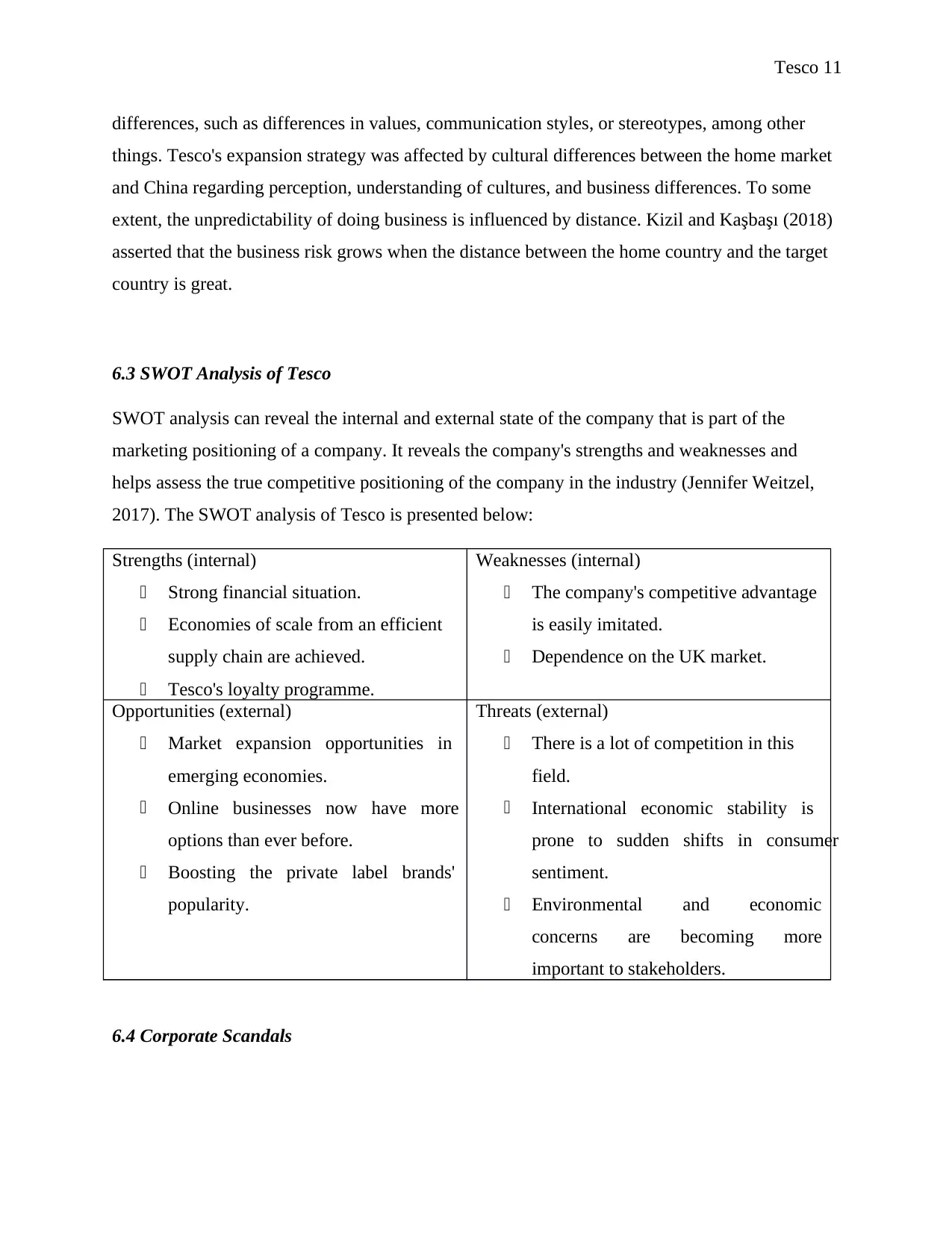
Tesco 11
differences, such as differences in values, communication styles, or stereotypes, among other
things. Tesco's expansion strategy was affected by cultural differences between the home market
and China regarding perception, understanding of cultures, and business differences. To some
extent, the unpredictability of doing business is influenced by distance. Kizil and Kaşbaşı (2018)
asserted that the business risk grows when the distance between the home country and the target
country is great.
6.3 SWOT Analysis of Tesco
SWOT analysis can reveal the internal and external state of the company that is part of the
marketing positioning of a company. It reveals the company's strengths and weaknesses and
helps assess the true competitive positioning of the company in the industry (Jennifer Weitzel,
2017). The SWOT analysis of Tesco is presented below:
Strengths (internal)
Strong financial situation.
Economies of scale from an efficient
supply chain are achieved.
Tesco's loyalty programme.
Weaknesses (internal)
The company's competitive advantage
is easily imitated.
Dependence on the UK market.
Opportunities (external)
Market expansion opportunities in
emerging economies.
Online businesses now have more
options than ever before.
Boosting the private label brands'
popularity.
Threats (external)
There is a lot of competition in this
field.
International economic stability is
prone to sudden shifts in consumer
sentiment.
Environmental and economic
concerns are becoming more
important to stakeholders.
6.4 Corporate Scandals
differences, such as differences in values, communication styles, or stereotypes, among other
things. Tesco's expansion strategy was affected by cultural differences between the home market
and China regarding perception, understanding of cultures, and business differences. To some
extent, the unpredictability of doing business is influenced by distance. Kizil and Kaşbaşı (2018)
asserted that the business risk grows when the distance between the home country and the target
country is great.
6.3 SWOT Analysis of Tesco
SWOT analysis can reveal the internal and external state of the company that is part of the
marketing positioning of a company. It reveals the company's strengths and weaknesses and
helps assess the true competitive positioning of the company in the industry (Jennifer Weitzel,
2017). The SWOT analysis of Tesco is presented below:
Strengths (internal)
Strong financial situation.
Economies of scale from an efficient
supply chain are achieved.
Tesco's loyalty programme.
Weaknesses (internal)
The company's competitive advantage
is easily imitated.
Dependence on the UK market.
Opportunities (external)
Market expansion opportunities in
emerging economies.
Online businesses now have more
options than ever before.
Boosting the private label brands'
popularity.
Threats (external)
There is a lot of competition in this
field.
International economic stability is
prone to sudden shifts in consumer
sentiment.
Environmental and economic
concerns are becoming more
important to stakeholders.
6.4 Corporate Scandals
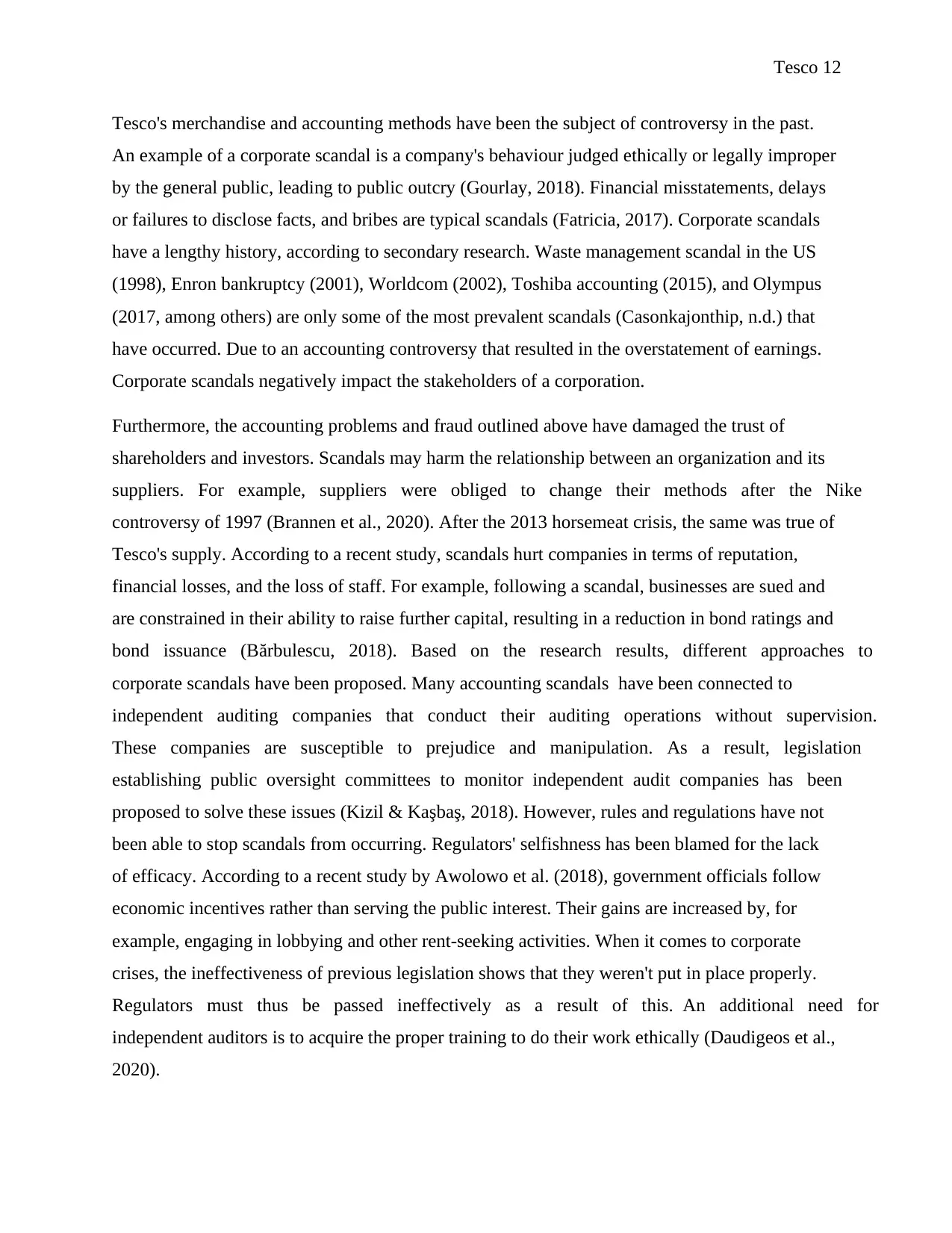
Tesco 12
Tesco's merchandise and accounting methods have been the subject of controversy in the past.
An example of a corporate scandal is a company's behaviour judged ethically or legally improper
by the general public, leading to public outcry (Gourlay, 2018). Financial misstatements, delays
or failures to disclose facts, and bribes are typical scandals (Fatricia, 2017). Corporate scandals
have a lengthy history, according to secondary research. Waste management scandal in the US
(1998), Enron bankruptcy (2001), Worldcom (2002), Toshiba accounting (2015), and Olympus
(2017, among others) are only some of the most prevalent scandals (Casonkajonthip, n.d.) that
have occurred. Due to an accounting controversy that resulted in the overstatement of earnings.
Corporate scandals negatively impact the stakeholders of a corporation.
Furthermore, the accounting problems and fraud outlined above have damaged the trust of
shareholders and investors. Scandals may harm the relationship between an organization and its
suppliers. For example, suppliers were obliged to change their methods after the Nike
controversy of 1997 (Brannen et al., 2020). After the 2013 horsemeat crisis, the same was true of
Tesco's supply. According to a recent study, scandals hurt companies in terms of reputation,
financial losses, and the loss of staff. For example, following a scandal, businesses are sued and
are constrained in their ability to raise further capital, resulting in a reduction in bond ratings and
bond issuance (Bărbulescu, 2018). Based on the research results, different approaches to
corporate scandals have been proposed. Many accounting scandals have been connected to
independent auditing companies that conduct their auditing operations without supervision.
These companies are susceptible to prejudice and manipulation. As a result, legislation
establishing public oversight committees to monitor independent audit companies has been
proposed to solve these issues (Kizil & Kaşbaş, 2018). However, rules and regulations have not
been able to stop scandals from occurring. Regulators' selfishness has been blamed for the lack
of efficacy. According to a recent study by Awolowo et al. (2018), government officials follow
economic incentives rather than serving the public interest. Their gains are increased by, for
example, engaging in lobbying and other rent-seeking activities. When it comes to corporate
crises, the ineffectiveness of previous legislation shows that they weren't put in place properly.
Regulators must thus be passed ineffectively as a result of this. An additional need for
independent auditors is to acquire the proper training to do their work ethically (Daudigeos et al.,
2020).
Tesco's merchandise and accounting methods have been the subject of controversy in the past.
An example of a corporate scandal is a company's behaviour judged ethically or legally improper
by the general public, leading to public outcry (Gourlay, 2018). Financial misstatements, delays
or failures to disclose facts, and bribes are typical scandals (Fatricia, 2017). Corporate scandals
have a lengthy history, according to secondary research. Waste management scandal in the US
(1998), Enron bankruptcy (2001), Worldcom (2002), Toshiba accounting (2015), and Olympus
(2017, among others) are only some of the most prevalent scandals (Casonkajonthip, n.d.) that
have occurred. Due to an accounting controversy that resulted in the overstatement of earnings.
Corporate scandals negatively impact the stakeholders of a corporation.
Furthermore, the accounting problems and fraud outlined above have damaged the trust of
shareholders and investors. Scandals may harm the relationship between an organization and its
suppliers. For example, suppliers were obliged to change their methods after the Nike
controversy of 1997 (Brannen et al., 2020). After the 2013 horsemeat crisis, the same was true of
Tesco's supply. According to a recent study, scandals hurt companies in terms of reputation,
financial losses, and the loss of staff. For example, following a scandal, businesses are sued and
are constrained in their ability to raise further capital, resulting in a reduction in bond ratings and
bond issuance (Bărbulescu, 2018). Based on the research results, different approaches to
corporate scandals have been proposed. Many accounting scandals have been connected to
independent auditing companies that conduct their auditing operations without supervision.
These companies are susceptible to prejudice and manipulation. As a result, legislation
establishing public oversight committees to monitor independent audit companies has been
proposed to solve these issues (Kizil & Kaşbaş, 2018). However, rules and regulations have not
been able to stop scandals from occurring. Regulators' selfishness has been blamed for the lack
of efficacy. According to a recent study by Awolowo et al. (2018), government officials follow
economic incentives rather than serving the public interest. Their gains are increased by, for
example, engaging in lobbying and other rent-seeking activities. When it comes to corporate
crises, the ineffectiveness of previous legislation shows that they weren't put in place properly.
Regulators must thus be passed ineffectively as a result of this. An additional need for
independent auditors is to acquire the proper training to do their work ethically (Daudigeos et al.,
2020).
⊘ This is a preview!⊘
Do you want full access?
Subscribe today to unlock all pages.

Trusted by 1+ million students worldwide
1 out of 18
Related Documents
Your All-in-One AI-Powered Toolkit for Academic Success.
+13062052269
info@desklib.com
Available 24*7 on WhatsApp / Email
![[object Object]](/_next/static/media/star-bottom.7253800d.svg)
Unlock your academic potential
Copyright © 2020–2025 A2Z Services. All Rights Reserved. Developed and managed by ZUCOL.




